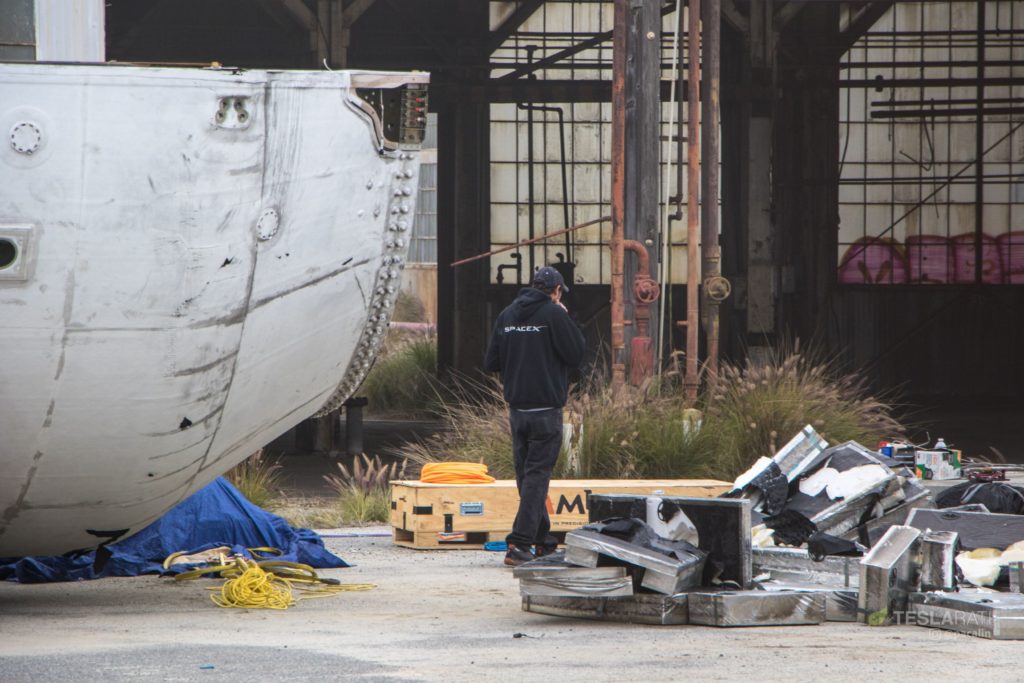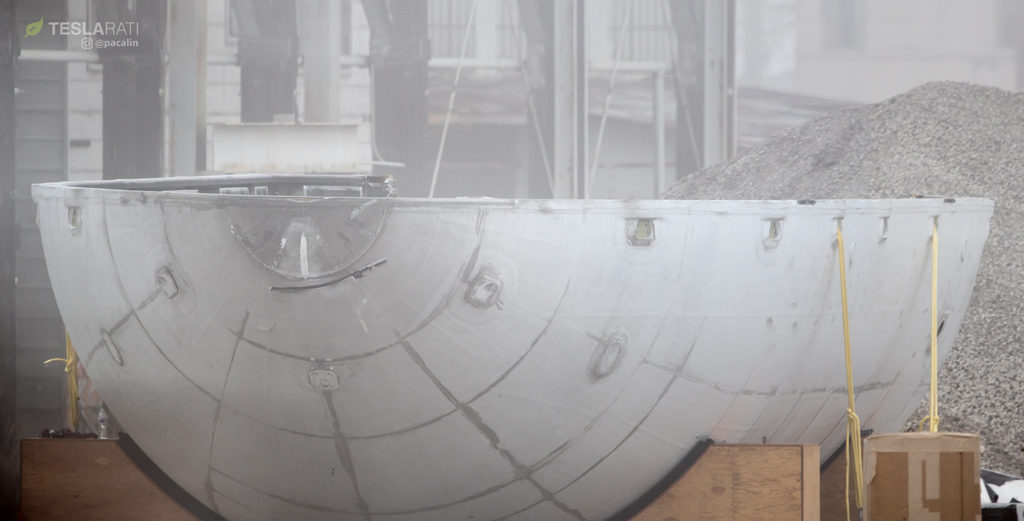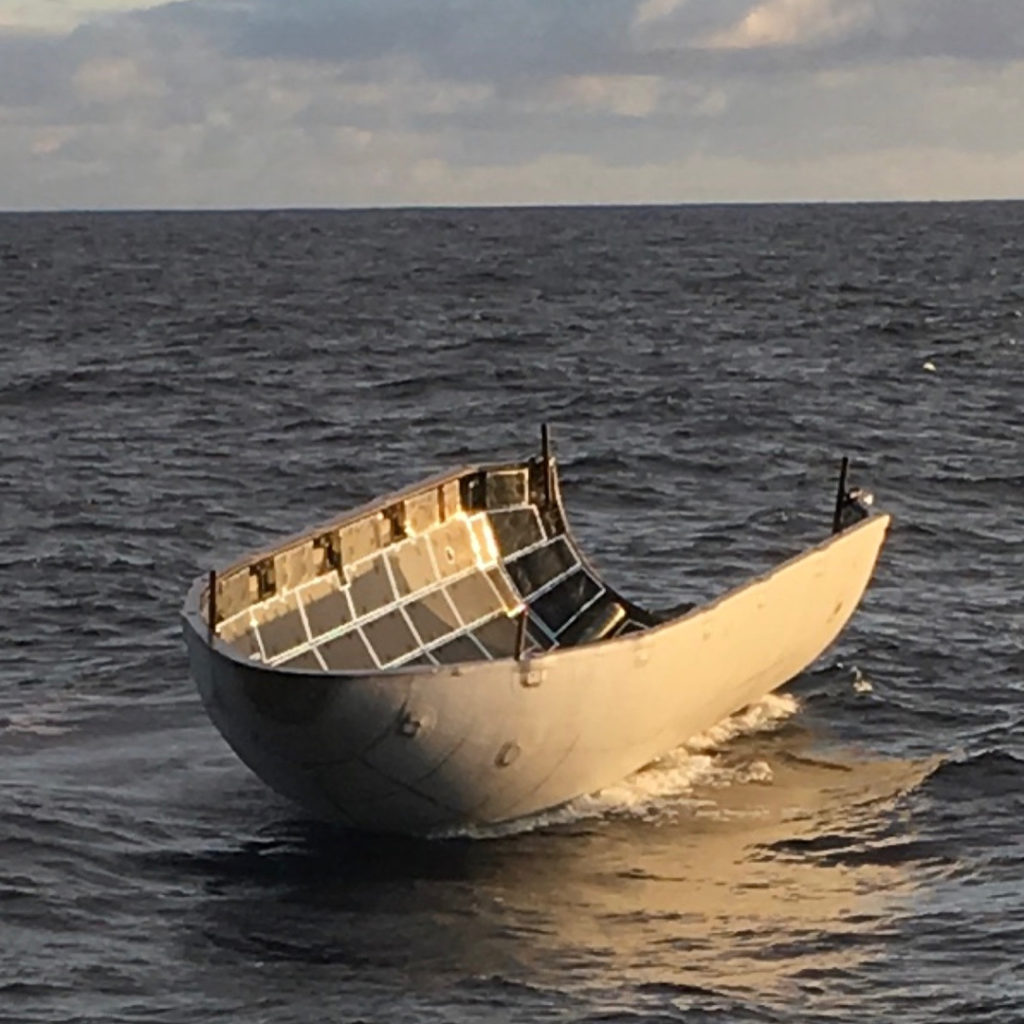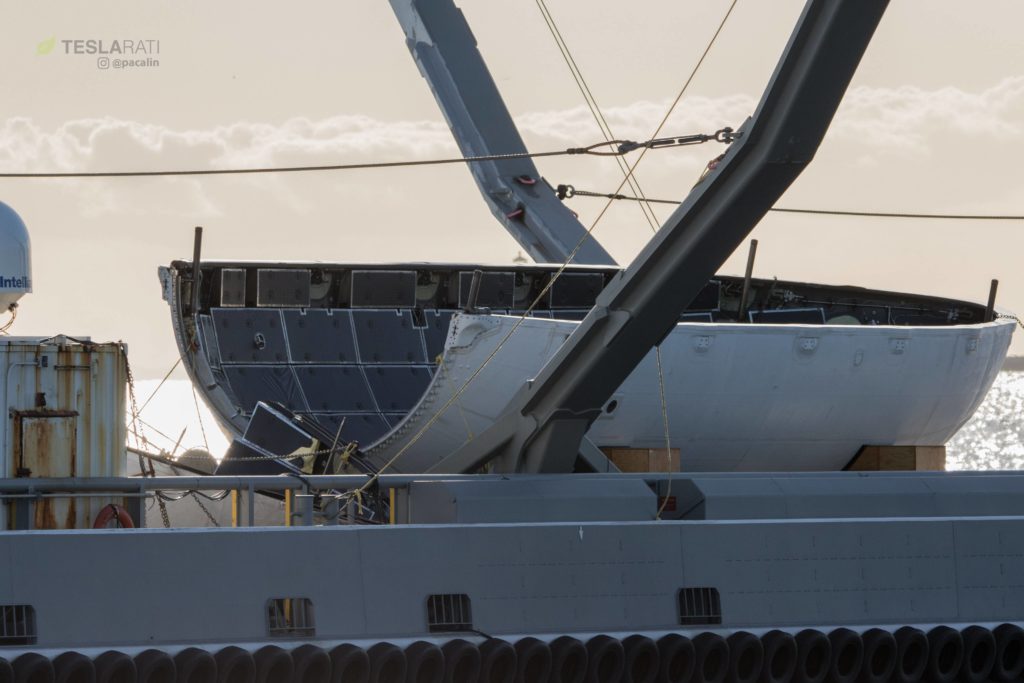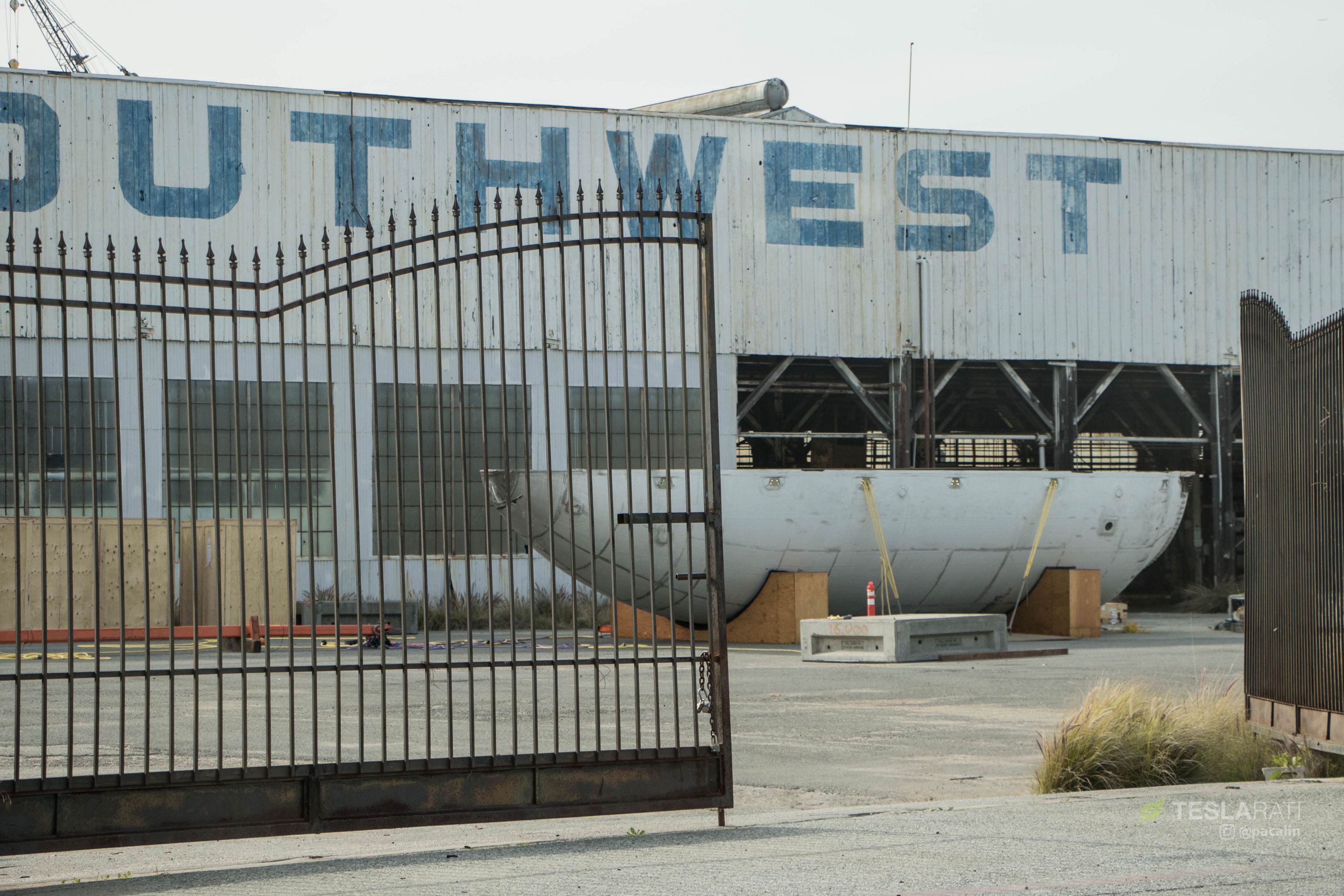

News
SpaceX recovered fairing appears at future Mars rocket factory in LA
In an unexpected turn of events, the first fairing half recovered by SpaceX – just after the Feb. 22 launch of PAZ – appeared at the company’s just-leased facilities at LA’s Port of San Pedro, also known as Berth 240 or SpaceX’s preferred location for the first BFR (Mars rocket) factory.
If there was any doubt before that SpaceX was not serious about the Port proposal released in March, or that individuals with SpaceX shirts at 240 were a mere coincidence, the arrival of an entire fairing half and two fairly large cranes ought to confirm the reality of the company’s active presence at the facility. After heading down to the port at dawn to capture Mr Steven’s arrival post-launch (providing a fairing surprise of its own), Teslarati photographer Pauline Acalin made a quick detour to Berth 240 to check up on any potential activity at the SpaceX-leased site.

SpaceX’s first recovered fairing spotted at the BFR factory (Pauline Acalin)
Lo and behold, she found a lone recovered fairing half sitting just off the side of the public Port access road, behind the plot’s fenced enclosure. A giant Z (a la PAZ) on the fairing’s face identified it beyond any doubt to be the half that soft-landed intact just over a month ago. For such a unique pathfinder as the first apparently intact fairing half to be recovered, its uncovered storage out in the open dockside air tells us a fair bit about the reality of its condition: while it’s still surprising that this half did not spend more time (perhaps no time at all) in SpaceX’s Hawthorne facilities, this almost guarantees that the fairing suffered some form of catastrophic and irreparable damage at some point during its recovery.
- PAZ’ fairing half in all its sooty, damaged glory. (Pauline Acalin)
RIP fairing half
If this fairing were in a flightworthy state, it would undoubtedly be safely stowed inside SpaceX’s Hawthorne facilities for many weeks or even months of careful testing and analysis to properly characterize the condition of the first fairing to be recovered in one piece.
Another possibility: perhaps SpaceX has already managed that characterization and refinement through the many different fairing fragments recovered during past (unsuccessful) attempts. Ultimately, it should come as little surprise that the fairing wound up damaged – the range of conditions it was subjected to boggle the mind. Its damage may have come from post-recovery handling, perhaps something as simple as the surface tension of seawater or some water intrusion inflating its density and overloading the fairing’s structure while it was craned or dragged aboard Mr. Steven. Its loss would appear to confirm that Mr. Steven’s seemingly elaborate net system exists for very specific and technical reasons, instead of, say, a group of engineers realizing that they could convince their managers to let them build a giant claw-boat. Sometimes the crazy solution can be the right solution!
- A closeup of the landed fairing. This particularly fairing is the first flight of Fairing 2.0, a recent upgrade. (Elon Musk)
- The first fairing to ever return to land intact proudly sails into Port of San Pedro aboard Mr Steven. (Pauline Acalin)
Either way, SpaceX technicians have unequivocally begun to tear down the PAZ half’s many interior components, ranging from baffles and soundproofing panels to parafoil connectors and cold-gas maneuvering thrusters. It’s conceivable that some of those parts can be reused on future missions, partly thanks to the fact that this half remained intact after landing, keeping its interior mostly dry. Given the sheer size of the cranes brought on-site on Saturday (March 31), it seems implausible that they are there just for PAZ’ fairing – more likely, they have been rented or purchased by SpaceX and will be used for a variety of tasks related to the demolition and construction outlined in the Port’s Berth 240 lease and use-case approval.
This is almost certainly the first time that SpaceX’s Berth 240 has hosted real rocket hardware, and hopefully foreshadows a bright and busy future of reusable rocket recovery, refurbishment, and manufacturing (hopefully with BFR!).
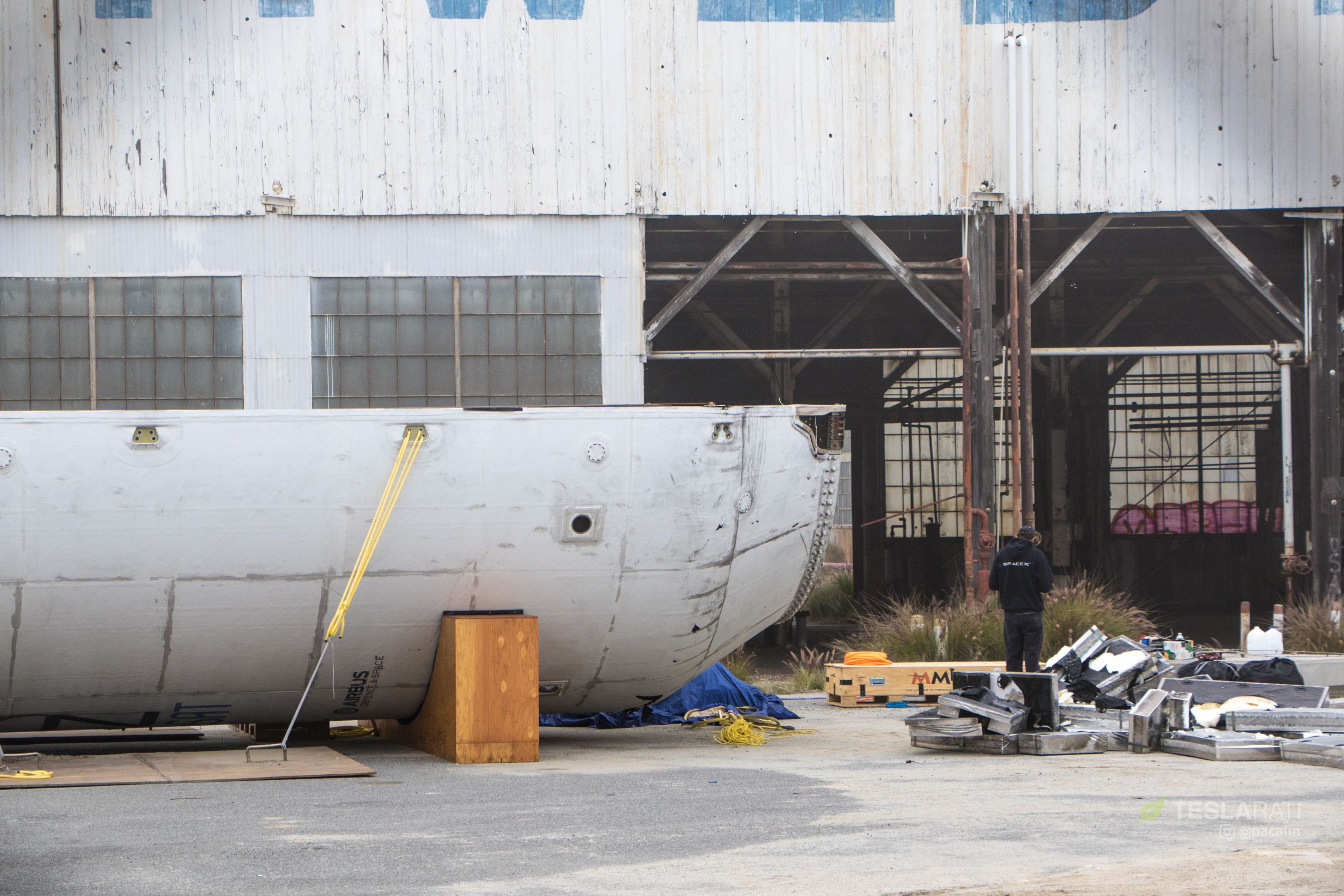
NBD, just scrapping a fairing in an abandoned shipyard. (Pauline Acalin)
Follow us for live updates, behind-the-scenes sneak peeks, and a sea of beautiful photos from our East and West coast photographers.
Teslarati – Instagram – Twitter
Tom Cross – Twitter
Pauline Acalin – Twitter
Eric Ralph – Twitter
News
Tesla launches in India with Model Y, showing pricing will be biggest challenge
Tesla finally got its Model Y launched in India, but it will surely come at a price for consumers.

Tesla has officially launched in India following years of delays, as it brought its Model Y to the market for the first time on Tuesday.
However, the launch showed that pricing is going to be its biggest challenge. The all-electric Model Y is priced significantly higher than in other major markets in which Tesla operates.
On Tuesday, Tesla’s Model Y went up for sale for 59,89,000 rupees for the Rear-Wheel Drive configuration, while the Long Range Rear-Wheel Drive was priced at 67,89,000.
This equates to $69,686 for the RWD and $78,994 for the Long Range RWD, a substantial markup compared to what these cars sell for in the United States.
🚨 Here’s the difference in price for the Tesla Model Y in the U.S. compared to India.
🚨 59,89,000 is $69,686
🚨 67,89,000 is $78,994 pic.twitter.com/7EUzyWLcED— TESLARATI (@Teslarati) July 15, 2025
Deliveries are currently scheduled for the third quarter, and it will be interesting to see how many units they can sell in the market at this price point.
The price includes tariffs and additional fees that are applied by the Indian government, which has aimed to work with foreign automakers to come to terms on lower duties that increase vehicle cost.
Tesla Model Y seen testing under wraps in India ahead of launch
There is a chance that these duties will be removed, which would create a more stable and affordable pricing model for Tesla in the future. President Trump and Indian Prime Minister Narendra Modi continue to iron out those details.
Maharashtra Chief Minister Devendra Fadnavis said to reporters outside the company’s new outlet in the region (via Reuters):
“In the future, we wish to see R&D and manufacturing done in India, and I am sure at an appropriate stage, Tesla will think about it.”
It appears to be eerily similar to the same “game of chicken” Tesla played with Indian government officials for the past few years. Tesla has always wanted to enter India, but was unable to do so due to these import duties.
India wanted Tesla to commit to building a Gigafactory in the country, but Tesla wanted to test demand first.
It seems this could be that demand test, and the duties are going to have a significant impact on what demand will actually be.
Elon Musk
Tesla ups Robotaxi fare price to another comical figure with service area expansion
Tesla upped its fare price for a Robotaxi ride from $4.20 to, you guessed it, $6.90.

Tesla has upped its fare price for the Robotaxi platform in Austin for the first time since its launch on June 22. The increase came on the same day that Tesla expanded its Service Area for the Robotaxi ride-hailing service, offering rides to a broader portion of the city.
The price is up from $4.20, a figure that many Tesla fans will find amusing, considering CEO Elon Musk has used that number, as well as ’69,’ as a light-hearted attempt at comedy over the past several years.
Musk confirmed yesterday that Tesla would up the price per ride from that $4.20 point to $6.90. Are we really surprised that is what the company decided on, as the expansion of the Service Area also took effect on Monday?
But the price is now a princely $6.90, as foretold in the prophecy 😂
— Elon Musk (@elonmusk) July 14, 2025
The Service Area expansion was also somewhat of a joke too, especially considering the shape of the new region where the driverless service can travel.
I wrote yesterday about how it might be funny, but in reality, it is more of a message to competitors that Tesla can expand in Austin wherever it wants at any time.
Tesla’s Robotaxi expansion wasn’t a joke, it was a warning to competitors
It was only a matter of time before the Robotaxi platform would subject riders to a higher, flat fee for a ride. This is primarily due to two reasons: the size of the access program is increasing, and, more importantly, the service area is expanding in size.
Tesla has already surpassed Waymo in Austin in terms of its service area, which is roughly five square miles larger. Waymo launched driverless rides to the public back in March, while Tesla’s just became available to a small group in June. Tesla has already expanded it, allowing new members to hail a ride from a driverless Model Y nearly every day.
The Robotaxi app is also becoming more robust as Tesla is adding new features with updates. It has already been updated on two occasions, with the most recent improvements being rolled out yesterday.
Tesla updates Robotaxi app with several big changes, including wider service area
News
Tesla Model Y and Model 3 dominate U.S. EV sales despite headwinds
Tesla’s two mainstream vehicles accounted for more than 40% of all EVs sold in the United States in Q2 2025.

Tesla’s Model Y and Model 3 remained the top-selling electric vehicles in the U.S. during Q2 2025, even as the broader EV market dipped 6.3% year-over-year.
The Model Y logged 86,120 units sold, followed by the Model 3 at 48,803. This means that Tesla’s two mainstream vehicles accounted for 43% of all EVs sold in the United States during the second quarter, as per data from Cox Automotive.
Tesla leads amid tax credit uncertainty and a tough first half
Tesla’s performance in Q2 is notable given a series of hurdles earlier in the year. The company temporarily paused Model Y deliveries in Q1 as it transitioned to the production of the new Model Y, and its retail presence was hit by protests and vandalism tied to political backlash against CEO Elon Musk. The fallout carried into Q2, yet Tesla’s two mass-market vehicles still outsold the next eight EVs combined.
Q2 marked just the third-ever YoY decline in quarterly EV sales, totaling 310,839 units. Electric vehicle sales, however, were still up 4.9% from Q1 and reached a record 607,089 units in the first half of 2025. Analysts also expect a surge in Q3 as buyers rush to qualify for federal EV tax credits before they expire on October 1, Cox Automotive noted in a post.
Legacy rivals gain ground, but Tesla holds its commanding lead
General Motors more than doubled its EV volume in the first half of 2025, selling over 78,000 units and boosting its EV market share to 12.9%. Chevrolet became the second-best-selling EV brand, pushing GM past Ford and Hyundai. Tesla, however, still retained a commanding 44.7% electric vehicle market share despite a 12% drop in in Q2 revenue, following a decline of almost 9% in Q1.
Incentives reached record highs in Q2, averaging 14.8% of transaction prices, roughly $8,500 per vehicle. As government support winds down, the used EV market is also gaining momentum, with over 100,000 used EVs sold in Q2.
Q2 2025 Kelley Blue Book EV Sales Report by Simon Alvarez on Scribd
-

 News3 days ago
News3 days agoTesla debuts hands-free Grok AI with update 2025.26: What you need to know
-

 Elon Musk1 week ago
Elon Musk1 week agoElon Musk confirms Grok 4 launch on July 9 with livestream event
-

 Elon Musk5 days ago
Elon Musk5 days agoxAI launches Grok 4 with new $300/month SuperGrok Heavy subscription
-

 News2 weeks ago
News2 weeks agoTesla Model 3 ranks as the safest new car in Europe for 2025, per Euro NCAP tests
-

 Elon Musk2 weeks ago
Elon Musk2 weeks agoxAI’s Memphis data center receives air permit despite community criticism
-

 News5 days ago
News5 days agoTesla begins Robotaxi certification push in Arizona: report
-

 Elon Musk2 weeks ago
Elon Musk2 weeks agoTesla scrambles after Musk sidekick exit, CEO takes over sales
-

 Elon Musk2 weeks ago
Elon Musk2 weeks agoTesla reveals it is using AI to make factories more sustainable: here’s how

